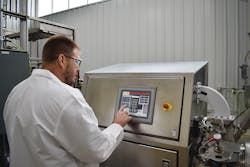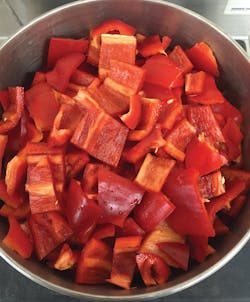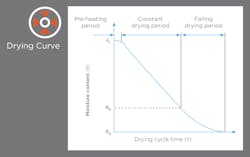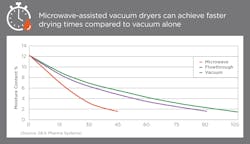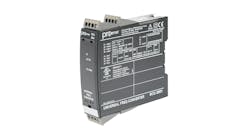Thermal processing refers to changing the temperature of a material with the intention of changing its state in some way. Thermal processing technology is used in heavy manufacturing industries for processing metals and building materials, as well as for industries such as food and beverage, pharmaceuticals, chemical, biomass and numerous other applications. Let’s examine the broad thermal processing technologies most common in consumer and packaged goods industries.
Thermal processing can be performed by direct or indirect methods, with indirect being the most widespread. The key difference is that direct methods are based on generating heat/energy within the material itself, whereas indirect relies on transfer heat generated from another source and applied to the material either through conduction or convection.
This article focuses on the wide-ranging use of thermal processing for drying and microbial reduction of materials, though the considerations are also relevant for other applications of thermal processing such as activating chemical processes, crystallization, degassing and cooking or other types of alterations in the nature of the materials.
Different thermal processing methods vary in terms of:
- Energy usage and efficiency
- Accuracy and precision of drying temperatures
- Speed of processing
- Uniformity of the temperature applied throughout the materials
- Temperature range at which they operate
- Ability to handle friable or delicate materials
- Capability of controlling the boiling point (through vacuum technology)
- Capacity for the volume and throughput of materials
- Retention of qualities such as chemical viability, nutritional value, color and aroma of final products
- Wastage of material, either through mechanical loss or due to quality problems such as sticking, burning, case hardening and inconsistency in output
- Sanitation and maintenance requirements
Applications
Many of today’s powdered products, highly nutritional processed foods, pharmaceutical and some organic products would not be possible without advances in thermal processing precision. As the capability of drying and processing advances, the quality of the finished product can be improved.
Sample applications include:
Biomass:
- Low temperature drying of cannabis, hops and other agricultural products
Minerals:
- Low moisture drying of carbon black, calcium carbonate and titanium dioxide
- Coating and drying of ceramics
Food:
- Dehydration of fruits, vegetables and meats
- Microbial reduction in food powders
- Extraction
- Pasteurization
- Roasting
- Thawing of IQF products
Pharmaceuticals:
- Drying of powders, including active pharmaceutical ingredients
Chemical:
- Change of state
- Solvent removal
Specialty applications:
- Nanocrystal and nanomaterial processing
Technological advances in thermal processing
Industrial equipment for thermal processing can have a lifespan of decades. As a result, engineers looking to replace or supplement existing equipment may not have investigated their options for several years. And they may end up making the mistake of simply purchasing a repeat of equipment already installed in their plant due to familiarity.
However, the needs of manufacturers and demands on finished products are evolving; a thorough investigation of the thermal processing technology available is essential.
Engineers should look for advances in the form of improved energy efficiency, cleanability and the combination of multiple technologies in a single piece of equipment to deliver maximum flexibility. Through the combination of technologies, manufacturers are creating breakthroughs in both process and product, many times changing their competitive landscape.
Thermal processing technology options
Drying technologies typically fall into the following general categories:
- Flash: Flash dryers combine agitation, hot gases and forced air to separate moisture from solid materials. Flash dryers use very high temperatures for a short time, while moving the materials.
- Fluid Bed: Fluid bed dryers work by allowing heated, high-pressure air or process gas to flow through a bed of material in an upward direction at a velocity greater than the settling rate of the particles. At this state, the bed is fluidized and the particles begin to dry.
- Freeze: Freeze drying, also known as lyophilization, is a water-removal process that involves three stages: freezing, primary drying (sublimation) and secondary drying (absorption).
- Microwave: Microwave heating is a direct method of heating, where the materials being processed heat at the molecular level, rather than by being in contact with heat from the outside. Microwave has been gaining popularity in many industrial applications because of its versatility and precise heating capabilities. Microwave energy can be applied within mixers, kettles, conveyors or ovens.
- Rotary: Rotary drum dryers use rotational cylinders that allow materials to cascade inside the drum while heat is applied to extract moisture, resulting in a dry product. Drums can produce sheets, powders and flakes from the materials being handled.
- Spray: Spray dryers use an atomizer or spray nozzle to distribute a stream of hot air to produce dry powders, granules or agglomerates from a liquid or slurry. Rotary disk and single-fluid, high-pressure nozzles are the most common types of equipment used for spray dryers.
- Tunnel: Tunnel dryers are a type of air and oven dryer. Tunnel dryers can provide large-scale heating and drying. Continuous tunnel dryers may offer varying heat levels at different zones of the conveyer area.
- In addition to the equipment listed above, options can sometimes be incorporated to shorten processing times, increase efficiency or produce more precise results. The technologies that are often applied include:
- Agitation: Movement, and more importantly mixing of materials, can be achieved by shaking, rolling or the use of paddle/ribbon agitators. This can increase the rate of heating and deliver more consistent results.
- Vacuum: When applied, vacuum can reduce the boiling point of specific materials, allowing the processing of sensitive materials at a lower temperature. Vacuum is also used in some applications to aid in the removal of water from the materials, thus shortening the processing times.
Considerations for different types of materials
Depending on the drying requirements for the materials, manufacturers should consider several options. The following are some of the important requirements and the dryers that correlate to match these requirements. Many factors help determine the appropriate thermal processing technology for a specific application, but there are general rules of thumb based on the identified requirements.
- Low temperatures: freeze drying, microwave, tunnel
- Precise temperature ranges: fluid bed, microwave, tunnel
- High temperature: flash, rotary, tunnel
- Fast drying: flash, spray
- Sensitive materials: microwave, freeze
- Energy efficiency: flash dryer, microwave
- Preservation of flavor, color and chemical properties: freeze dryer, microwave
- Low water content: microwave, fluid bed
- High water content: flash dryers, rotary dryers
- Potential flammability: microwave, tunnel, rotary
- Sticky, wet or coagulating materials: rotary, microwave
- Requires mixing while processing: rotary dryers, microwave
- Continuous processing: fluid bed, tunnel dryers, rotary dryers, microwave
- Ease of sanitation: flash, freeze, microwave
Additional considerations for specific applications
The following list highlights some of the specific advantages and disadvantages associated with the different equipment.
Consider
- Spray and flash dryers can reach particularly high rates of moisture removal.
- Freeze dryers provide appealing texture, nutritional value and flavor retention.
- Microwave heating is extremely versatile and precise. Microwave is effective for maintaining chemical qualities as well as flavor, color and nutritional value for food. It is one of the most energy-efficient thermal processing methodologies and one of the safest (no hot surfaces or chemicals).
- Rotary or drum dryers can compress product for sheet applications, can dry liquids without loss of materials and can handle viscous materials.
- Spray drying enables control of particle size, bulk density, degree of crystallinity, organic volatile impurities and residual solvent levels. Most spray-dried particles are spherical, which makes downstream operations, like packaging and filtering, easier and less costly. Spray drying amorphous formulations can increase both solubility and bioavailability for pharmaceuticals.
- Tunnel dryers can reach very high temperatures and high throughput.
- Vacuum technology is important in thermal processing, as creating pressure in the drying container can reduce the boiling threshold of materials. Introduction of vacuum technology in microwave processing is particularly effective in the processing of materials once thought to be impossible to dry or make into powders without creating a deterioration in the quality of the material. Today, combinations of these technologies have produced breakthrough results in the ability to create powders that are easily reconstituted to retain their original potency.
Avoid
- Fluid bed dryers are not appropriate for materials that are liquid, too wet, sticky or adhesive.
- Rotary and drum dryers require a large footprint, heat up the surrounding space and are slow to heat and cool.
- Spray dryers also can suffer from high maintenance and parts replacement costs.
- Tunnel dryers have the potential to damage product through burning, case hardening or inconsistent heating.
- Freeze dryers take at least 24-48 hours to produce desired results and are available for batch processing only.
- Microwave processing can be used only for materials that have the capacity to interact with microwaves (water content).
Testing
Before purchasing any kind of thermal processing equipment, it’s essential to test in order to validate that the technology will produce the desired results. Reliable equipment manufacturers will generally have a laboratory or test facility, giving you the ability to understand how your material performs at both an R&D and pilot scale level to accurately predict and size your process requirements.
Many factors must be considered when it comes to identifying the appropriate drying technology for your application. Consulting with an experienced application engineer will help in the process, ensuring the right piece of thermal processing technology is not only selected, but optimized for years to come.
Jason Boyles is the Business Unit Director — WaveMix at Marion Process Solutions, a global provider of innovative thermal processing and mixing equipment. For more information about Thermal Processing, check out our Thermal Processing Handbook at https://info.marionsolutions.com/landing-page-0
